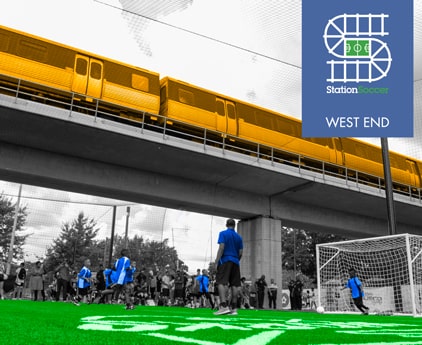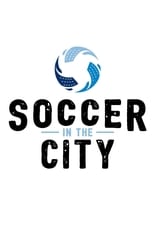The message of Soccer in the City is important: that at $1,500 to $5,500 per year, the pay-to-play model excludes low-income children. American soccer doesn’t reach inner city kids, who could be untapped potential to help win World Cups. In his feature-length debut, Director Michael Holstein shows urban efforts bearing fruit in DC, the Bronx, and Atlanta.
The documentary covers some of the inner city and urban kids who have made it to MLS or gotten on colleges’ radar. These teenagers and young adults are an important part of the solution because they become role models for little ones to aspire to emulate. For example, the Washington DC population is 75% Black, but kids mostly play the ubiquitous basketball and don’t think of playing soccer. Instead, they see soccer as a middle class White sport. Holstein shows East Coast organizations that are trying to change that perception.
Soccer for change programs
When I dug a little more into the soccer-for-good programs shown in Soccer in the City, I was truly impressed:
Soccer in the Streets in Atlanta has existed for 30 years. As of their 2018 Impact Report, they are in 28 Atlanta communities, have 5,000+ youth participants, and have piloted a Leadership Council program that resulted in a 95% high school graduation rate.

What I find particularly awesome is their StationSoccer program. They have already built 3 fields and are planning for 10 MARTA metro stations to improve access to urban kids, but they also administer adult leagues on those fields as a fundraiser. Soccer in the Streets looks like a fantastic program that is well-supported by the MLS fans and ownership of Atlanta United.
America Scores started in Washington DC in 1994 and now serves 13,000 inner-city youth across the country. Their program blends soccer + poetry + service learning to teach both teamwork and literacy. The film has snippets of their Poetry Slams, where the kids’ poetry is like rap. It’s very cool. Another benefit of these programs is that they provide coaching jobs for program graduates and/or a school’s teachers. I saw this in person back in 2015 when I visited local programs that the US Soccer Foundation sponsored in Redwood City, CA.
South Bronx United was founded in 2009, offers programs for over 1,300 low-income and immigrant children, and even provides immigration legal services. (According to their 2019 report, 3 of their families had been broken up by ICE.) Prince Amponsah was born in Ghana, started with SBU at age 7, and now plays in the development academy at MLS team New York City FC. NYCFC is an SBU sponsor, and Claudio Reyna — former USMNT star and former NYCFC sporting director (now Austin FC) — figures prominently in this film.
DC Scores is the flagship and founding site that grew into America Scores. The DC affiliate services 3,000 kids at 70 schools. Filmmaker Holstein provides marketing communications for both organizations. MLS team DC United collaborates extensively with DC Scores.
Open Goal Project was founded in 2015 in Washington DC by Amir Lowery and Simon Landau. Lowery played in MLS, and he and Landau started their project to give promising players the support necessary to succeed at higher levels, e.g. getting players onto travel teams. One of their stars is high school sophomore Precious Ogu, who has caught the eyes of college scouts. They also launched a few Chevron Soccer Academy mini-camps in California with star Brandi Chastain as well as former San Jose Earthquakes players Jordan Stewart, Victor Bernardez, and Dan Gargan, to mention a few.
The Philadelphia Union does not have a program like any of the above, but they have helped Chester High School to revive its soccer team. Home grown players Mark McKenzie and Auston Trusty are inner city products who now play in MLS.
Too much of an infomercial
The problem I found with the film is that it covers so many projects and has so many talking heads. It feels more like an infomercial than a documentary. I also felt it aggrandized what the MLS teams were doing for inner city youth, other than Atlanta United, whose contribution is substantial. MLS supports home growns for business reasons: young players are assets, and demonstrating community involvement is strategic. Maybe a deeper examination of the situations would have made me feel differently.
Filmmaker Holstein had a pretty large budget ($255,000) for a documentary, and part of that was used to explore the street soccer environment in Paris. If you want to learn more about soccer in France’s banlieues, watch the film Concrete Football. Other movies on soccer for the good of children and teens include The Anderson Monarchs, Futbolistas 4 Life, and In the Game. There are several Homeless World Cup movies about child and adult street teams.
Conclusion
Despite my reservations, the purpose of the film is great and true. If you have a chance this holiday season, send some cheer towards one or more of the groups above; I am sure they could use your help. These stories inspired me to further financially support soccer-for-good programs, and I hope you will too.
7 Soccer Movie Mom Rating = 7
Resources:
- Released: 2019-12-03 (USA)
- In English. 82 minutes
- IMDB
- Director: Michael Holstein
- Stars: Amir Lowery
- The film’s Facebook page has some “Sizzle Reels” but these segments are not in the final film, probably due to the cost of image rights.
- Facebook and on Twitter @SITCMovie

